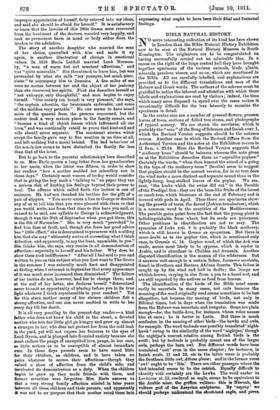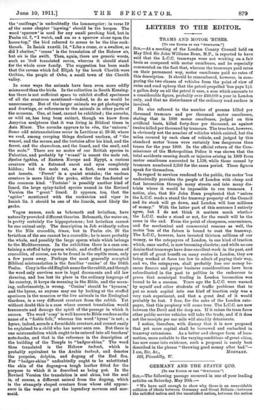BIBLE NATURAL HISTORY.
NO more interesting collection of its kind has been shown in London than the Bible Natural History Exhibition now to be seen at the Natural History Museum in South Kensington. The originators are to be congratulated on having successfully carried out an admirable idea. In a recess on the right of the large central hall they have brought together specimens of the various animals, birds, plants, minerals, precious stones, and so on, which are mentioned in the Bible. All are carefully labelled, and explanations are provided as to the different translations and uses of the Hebrew and Greek words. The authors of the scheme must be gratified to notice the interest and attention with which these labels and explanations are read by visitors ; indeed, the time which many seem disposed to spend over the cases makes it occasionally difficult for the less leisurely to examine the specimens in detail.
In the centre case are a number of pressed flowers, grasses, leaves of trees, sections of felled tree stems, and photographs of typical scenery. We are shown the narcissus, which is probably the " rose " of the Song of Solomon and Isaiah xxxv. 1, which the Revised Version suggests should be the autumn crocus. Another case in which the Revised differs from the Authorised Version and the notes at the Exhibition occurs in II Sam. v. 23-24. Here the Revised -Version suggests that "mulberry trees" should be balsams, whereas the note given us at the Exhibition describes them as " aspenlike poplars." Certainly the words, "when thou hearest the sound of a going in the tops of the mulberry trees" (becciim) seem to suggest that poplars should be the correct version, for in no tree does the wind make a more distinct and separate sound than in the lightly-hung, long-stalked leaves of the poplar. We see, next, "the husks which the swine did eat" in the Parable of the Prodigal Son : they are the beau-like fruits of the locust or carob tree, which blossoms at the end of February and is covered with pods in April. Then there are specimens show- ing the growth of tares, the darnel (Lotium temulentum), which is a common weed in the countries of the Mediterranean. The parable gains point from the fact that the young plant is indistinguishable from wheat, but its seeds are poisonous. Other problems in identification are not 80 easy. The sycamine of Luke xvii. 6 is probably the black mulberry, which is still known in Greece as sycaminea. But there is more doubt as to the gopher tree, which is mentioned only once, in Genesis vi. 14. Gopher wood, of which the Ark was made, seems most likely to be cypress, which is copher in Arabic, and is abundant in Chaldea, and Armenia. Another disputed identification is the manna of the wilderness. But it answers well enough to a certain lichen, Lecanora esculenta, found in Northern and Eastern African deserts. This lichen is caught up by the wind and laid in drifts ; the lumps are whitish-brown, -varying in size from a pea to a hazel-nut, and are still regarded by the natives as food from heaven.
The identification of the birds of the Bible must neces- sarily be uncertain in many cases, not only because the meaning of the word originally used seems sometimes to be lost altogether, but because the naming of birds, not only in Biblical times, but in days when the translation was made from the Hebrew was uncertain and irregular. Some are plain enough—tor, the turtle-dove, for instance, whose voice names him at once ; he is tarter in Latin. But there is much confusion in the naming of other birds—the hawks and owls, for example. The word tachmtis was possibly translated night- hawk ' owing to the similarity of the word nightjar,' though the nightjar's nearest relative among British birds is the swift; but by Mantels is probably meant one of the larger owls, perhaps the barn owl. But different words have been translated owl' even in the same chapter; for instance, in Isaiah xxxiv. 11 and 13, as in the latter verse is probably the Southern little owl, Athens glans; and in the former verse 'owl' ought to be ibis.' There are other passages where the bird intended seems to be the ostrich. Equally difficult to identify with certainty are the hawks. The word nesher in Leviticus xi. 13, rendered as eagle, seems to be equivalent to the Arabic fatter, the griffon vulture: this is Nisrooh, the vulture god of the Assyrian sculptures. By 'osprey' we should perhaps understand the short-toed eagle, and pares, the ossifrage,' is undoubtedly the lammergeier ; in verse 19 of the same chapter 'lapwing' should be the hoopoe. The word sparrow' is used for any small perching bird, but in Psalm cii. 7, "I watch, and am as a sparrow alone upon the house-top," the bird referred to seems to be the blue rock- thrush. In Isaiah xxxviii. 14, "Like a crane, or a swallow, so did I chatter," 'crane' is the translation of the Hebrew sis, but sir is the swift. Then, again, there are generic words, such as ?web translated raven, whereas it should stand for the whole crow family. The suggestion has been made that the ravens which fed Elijah by the brook Cherith were Orebim, the people of Orbo, a small town of the Cherith 'valley.
In some ways the animals have been even more oddly anisnalued than the birds. In the collection in South Kensing- ton there is not sufficient space to exhibit stuffed specimens of all the creatures mentioned—indeed, to do so would be unnecessary. But of the larger animals we get photographs and drawings, or references to the animals in other parts of the museum. One, at least, cannot be exhibited ; the aurochs, or wild ox, has long been extinct, though we know from Assyrian sculptures that it was living in Biblical times in Asia Minor. The aurochs appears to be rent, the unicorn.' Some odd mistranslations occur in Leviticus xi. 29-30, where we read, among creeping things declared unclean, of "the weasel, and the mouse, and the tortoise after his kind, and the ferret, and the chameleon, and the lizard, and the snail, and the mole." There are no moles of our British species in Palestine, and probably by weasel' is meant the mole rat, Spalax typhlus, of Eastern Europe and Egypt, a curious creature with a flattened snout and eyes completely hidden ; but the mole rat, as a fact, eats roots and not insects. 'Ferret' is a quaint mistake; the unclean creature is more likely the gecko, either the fan-footed or the common kind. 'Tortoise' is possibly another kind of lizard, the large spiny-tailed species named in the Revised Version the "great" lizard. It appears, too, that the ' spider ' mentioned with the cockatrice and viper in Isaiah lix. 5 should be one of the lizards, most likely the gecko.
Vague names, such as behemoth and leviathan, have naturally provoked different theories. Behemoth, the water-ox, is pretty certainly the hippopotamus ; but leviathan cannot be one animal only. The description in Job evidently refers to the Nile crocodile, timsa, but in Psalm civ. 26 the leviathan of the sea cannot be a crocodile ; he is more probably the whale, and possibly the large sperm whale which belongs to the Mediterranean. In the exhibition there is a case con- taining a stuffed baby sperm whale, and stuffed specimens of crocodiles, of course, are to be found in the reptile room, only a few paces away. Perhaps the most generally accapted Biblical mistranslation is the familiar 'conies' of the 104th Psalm. Cony is the old English name for the rabbit, and though the word only survives now in legal documents and old law phrasing, and has lost its place in the ordinary language of the country, it keeps its meaning in the Bible, and the mean- ing, unfortunately, is wrong. 'Conies' should be hyraxes,' and the hyrax, as anyone may see by looking at the stuffed specimen in the museum or the live animals in the Zoological Gardens, is a very different creature from the rabbit. Yet without doubt this is a case where correct translation would transmute and damage the spirit of the passage in which it occurs. The word cony' is well known to Bible readers as the name of a "feeble folk," whereas the word 'hyrax' is not ; a hyrax, indeed, sounds a formidable creature, and cannot easily be explained to a child who has never seen one. But there is one mistranslation which ought to be entered into all teachers' note-books, and that is the reference in the description of the building of the Temple to "badger-skins." The word thus translated is the Hebrew tachash, which is probably equivalent to the Arabic tuchash, and denotes the porpoise, dolphin, and dugong of the Red Sea. For "badger-skins" undoubtedly ought to be substituted the skin of the dugong—a tough leather fitted for the purpose to which it is described as being put. In the Revised Version the translation is seal skins, but the seal is, of course, a different animal from the dugong, which is the strangely shaped creature from whose odd appear- ance in the water we get the legendary merman and mer- =aid.











































 Previous page
Previous page